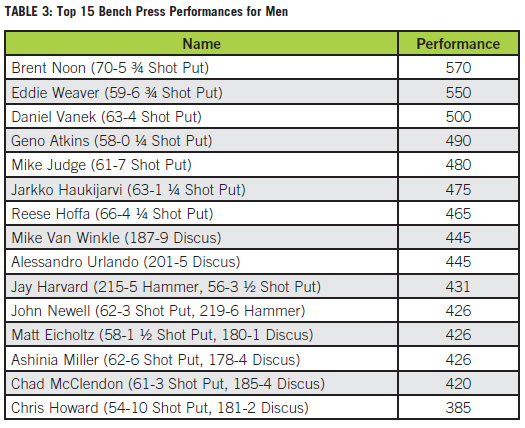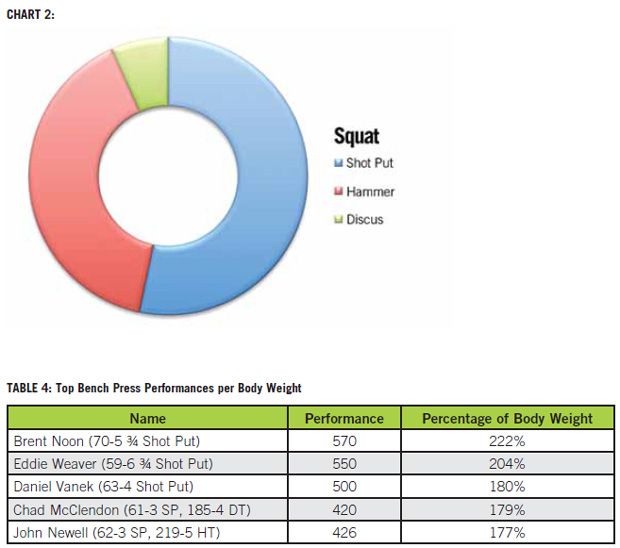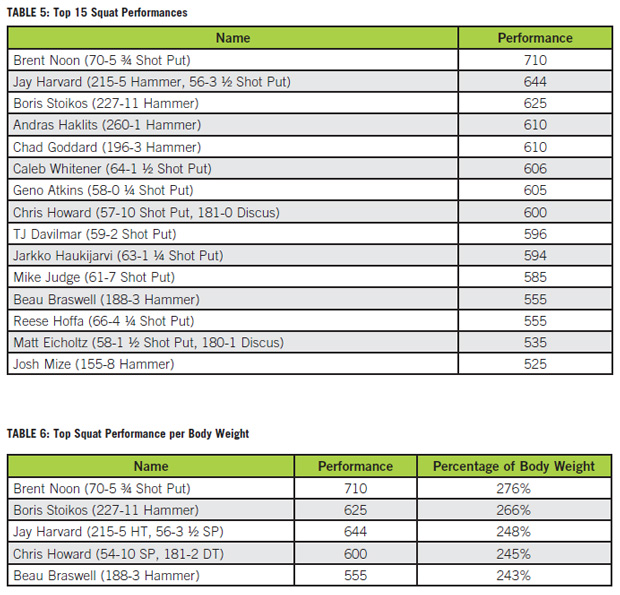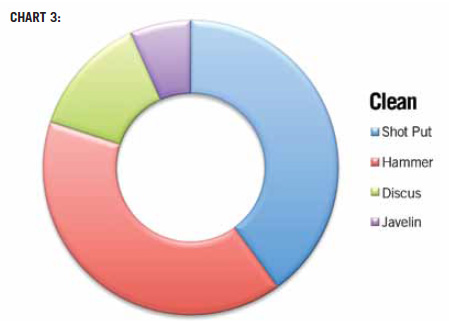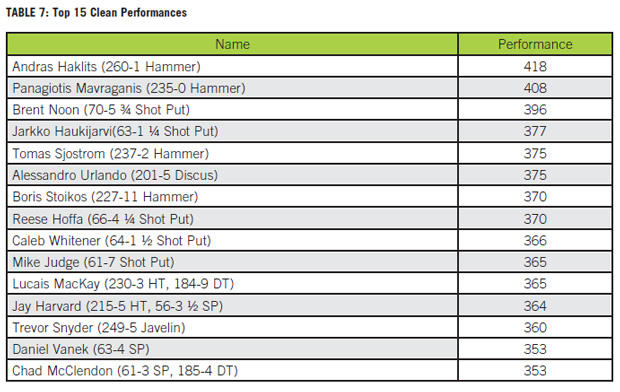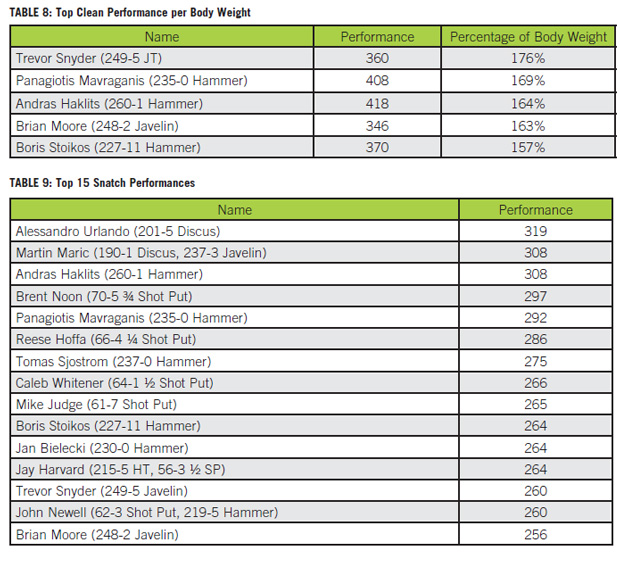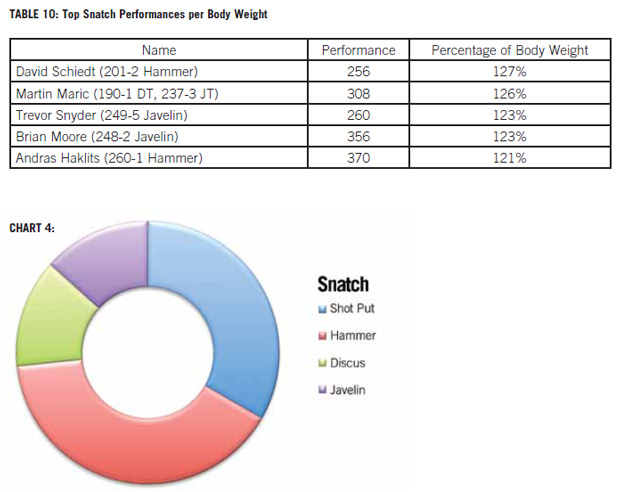| Pound for Pound: Weight Lifting and the Men's Throwing Events |
| By: Don Babbitt
Originally Published in: Techniques Magazine - Provided by: USTFCCCA
The purpose of this article is to provide a review of training results for male athletes attempting to compete at the highest level of NCAA competition in the four throwing disciplines. The aim is to highlight the type of lifting performances an NCAA coach may see when collecting data over the long term from their training groups. There is no intention of implying that the lifting results are statistically correlated with actual throwing performance. The only purpose is to provide a large sample of lifting results that one contrasts and compares with regard to the different throwing disciplines. General trends in the lifting performances will be discussed, and the results for these throwers will be discussed with regard to event type, strength to body weight ratio, and level of throwing performance. The statistics for the throwing athletes to be presented are from actual maximum performances and not on theoretical or extrapolated predictions from multiple repetitions. This data has also been accumulated from the throwers of the University of Georgia track and field program over the past 30 years, which has produced many successful performers in all four throwing disciplines at the NCAA level. Virtually all the athletes whose data is presented are between the ages of 18-24 years old. In addition, the lifting numbers are only representative of the training marks produced while on the team as undergraduates and are reported with their corresponding throwing performances. It should be noted that many of the throwers went on to continue throwing after college and later improved on both their throwing results and lifting results. MAXIMAL STRENGTH AND THE POWER LIFTS To begin, we will look at the maximum strength levels for the Olympic lifts and Power lifts, and see exactly what type of throwing athletes make up these lists. Table 1 shows the top 10 for the two-lift totals for the Power lifts (Bench Press and Back Squat) for the University of Georgia all-time throwers. The majority of the throwers who make up the top 10 Power lifters are shot putters, or the shot put is their primary throwing event. The high number of shot putters in the top ten power lifting lists makes sense for the following reasons. The shot is the heaviest implement of the four throwing events and requires the greatest percentage of final release speed development from the power position (85 percent). The shot is the heaviest implement of the four throwing disciplines, causing final release speeds lower than those of the javelin, discus and hammer. The combination of heavier implement and lower release speed suggests a correlation with a reliance on maximal strength rather than speed, to be successful. They are not as tall as the typical discus thrower, and they are larger in body mass than both javelin and hammer throwers. The larger mass and shorter leverage systems make shot putters better suited for generating bigger numbers in the power lifts. One other observation was made in that some of the shot putters who are in the top 10 for the power lifts are not necessarily the top athletes in terms of throwing performance. This suggests that merely being strong in the power lifts may not necessarily be a major factor in throwing success at this level, and hints that other factors such as timing and technical execution play a more prominent role in throwing success. However, the athletes who are strong in the weight room, but not as accomplished in throwing performance, can still have an important role in the group in pushing the more talented throwers in lifting performance while in the weight room. In summary, shot putters tend to be the strongest power-lifters in the throwing group, but the strongest power lifters were not necessarily the top throwers
MAXIMAL STRENGTH AND THE OLYMPIC LIFTS The top 10 lists for the Olympic lifting totals show a little variation from the Power lifting top 10 lists. The first observation that jumps out is that the shot putters do not dominate the Olympic lifts as much as the Power lifts. The second observation reveals that the athletes at the top of the Olympic lifting lists are among the top throwers in the history of the program. The top six performers on this list represent the school record holders for the shot put, discus and hammer, as well as the number two performer in school history in the shot put, and numbers two and three in the hammer throw (see Table 2). Every thrower in the top 10 Olympic lifting lists is also a member of the schools top 10 list in at least one of the four throwing disciplines, making them among the top performers in school history. The majority of these throwers have also scored at the NCAA meet (placing in the top eight). While it is not statistically confirmed, a quick look at these results make it appear that high performance in the fostering success in the various throwing events than the Power lifts. TOP PERFORMANCES IN THE BENCH PRESS
Examination of Table 3 shows that over 80 percent of the top 15 Bench Pressers in program history were shot putters, or throwers who were very good at shot (see Chart 1). For maximal bench press performance, this would make sense since shot putters tend to be the largest throwers and the bench press involves a motion that is very similar to the delivery pattern of the shot. Superior bench pressing performances are made possible because the large amount of weight that is lifted is a smaller percentage of the shot putters body weight when compared with traditionally smaller and lighter throwers such as javelin or hammer throwers. In addition, the shot putters leverage system (arms) used for bench pressing may not be quite as long as that of discus throwers, thus giving shot putters a biomechanical advantage in putting up larger amounts of weight in this particular lift. It should be noted however, that discus throwers were the second most prominent type of thrower in terms of bench press performance which does speak to the need to good upper body strength as a requirement for high level success in that throwing discipline.
In terms of bench press performance relative to body weight, the very best performers were once again shot putters. The top five in this category were able to lift between 180-220 percent of their body-weight (see Table 4). These top end percentages are representative of a very high level of accomplishment for the lift and are at least 30-40 percent higher than what is seen from the typical NCAA thrower. OP PERFORMANCES IN THE SQUAT The top performances in the back squat (thigh just below parallel) in relation to amount lifted and percentage of body-weight, were dominated by shot putters and hammer throwers (see Table 5). Three explanations can be put forth as to why these two event areas represent the top squatting performances. The shot putters are the largest throwers or had the physical build that gave them a mechanical advantage (shorter legs and wider hips) in squatting relative to "longer and taller" throwers such as discus and javelin throwers. Hammer throwers were the second most prominent on the list for top squatting performances. Many of these hammer throwers had typical hammer body types, characterized by modest height (no more than 6-feet 0-inches to 6-feet 1-inch) and strong legs which made them well-suited for success in the squat. Both the shot put and the hammer throwing sequences involve more vertical application of force against the ground (and hence a steeper release angle) compared with the discus and javelin throws, which have a larger translational movement component. This necessitates the ability to generate larger ground forces that can be developed with the use of an exercise like the squat. Another significant point of note with regard to the top 15 performance list for squat is that the best throwers were not necessarily the best squatters. While some of the throwers at the top of the list were school record holders or members of Georgia's top five performance list for a given event, nearly 50 percent were not in the top 10 or even top 15 on the event performance lists (see Chart 2). The top marks for squatting relative to percentage of body weight lifted registered between 245-275 percent (see Table 6). These are impressive results considering a squat of double body weight is considered a very high level for throwers who are looking to perform at the highest levels of competition at the NCAA level. However, it should be noted that the top five squatters for percentage of body weight lifted were between the height of 5-feet 11-inches and 6-feet 2-inches. This gives them a leverage advantage in producing high body weight percentage totals compared with taller or rangier throwers (like discus and javelin throwers). TOP ELRFORMANCES IN THE CLEAN The top 15 lifting table for cleans was made up of primarily shot putters and hammer throwers (see Table 7 and Chart 3). The throwing performance level of these 15 throwers were also very high, with every member of the list being in the throwing top 10, and over 70 percent being in the top five in program history in terms of throwing performance. The top five on the clean list have also placed no worse than third at the NCAA Championships in their respective events, with two of them being multiple NCAA Champions (Haklits & Noon). It is the primary reason for the makeup of this list are as follows: It is made up of many of the most talented and explosive throwers in program history. It consists of some of the largest throwers in program history, which means they will not have to lift as high a percentage of bodyweight to get on the list. It is made up of some of the most explosive, yet shorter throwers, who will have a mechanical advantage over taller throwers in the Olympic lifts, such as the clean. Unlike the make up of the top 15 clean max performance list, the top five performers in relation to bodyweight were either javelin throwers or hammer throwers (see Table 8). All five of these athletes were very obviously very explosive but were also shorter (two were 6-feet 2-inches, the other three were 6-feet 0-inches and under). The percentage of body-weight lifted for these five was between 157-176 percent, which is very good. One hundred and fifty percent of bodyweight lifted in the clean can be considered very good for a top level NCAA thrower.
TOP PERFORMANCES IN THE SNATCH As would be expected, the top 15 list for the snatch was very similar to that of the clean, with over 70 percent overlap between both lists (see Table 9). Like the members of the top 15 list for clean the best performers in the snatch were also top-level throwers. One third of these throwers would go on to participate in the Olympic Games or World Championships in their respective events. All 15 occupied spots on the Georgia's top 10 throwing lists and were NCAA Championships participants. Members of the snatch top 15 that were not in the top 15 in the clean could be characterized as lighter or longer and more athletic throwers. The snatch is considered the fastest lift in the weight room so it makes sense that faster and more athletic throwers would occupy the list. In terms of throwing event representation, the hammer throwers appeared to be the majority group in the snatch top 15 list (see Chart 4). Both discus throwers and javelin throwers also had a small presence in the top 15 as well. The top five snatch performers relative to body weight were represented primarily by hammer throwers and javelin throwers (see Table 10), and were some of the quickest and best jumpers in the history of the program with an average standing vertical jump of 33 inches. SUMMARY After examining these lifting performance tables we can draw five general trends about the relationship between lifting and its effect on throwing performance. High performance in the Olympic lifts has a little more in common with high performance in throwing than the power lifts. The top throwers in program history were the best Olympic lifters in the program, this was not necessarily the case at times with the Power lifts. The top bench pressers were shot putters and in a few cases discus throwers. Both events rely on upper body power more than the hammer throw or javelin throw. The top athletes in the squat were either some of the bigger throwers or shorter throwers. These throwers also came predominantly from the shot put and hammer events, which require more vertical application of force with the legs, and higher release angles, than do discus and javelin throwers. The top performers in the snatch, both in terms of both maximal weight lifted and percentage of body weight lifted, were generally the most "athletic" of the four lifting groups. The top snatchers were also the most diverse group in terms of having representatives from all four throwing disciplines as well. Don Babbitt has been the throws coach at the University of Georgia for nearly 20 years. Babbitt has coached 46 throwers who have competed in the Olympic Games or World Championships and that group has won nine medals, and 15 top five finishes. |







